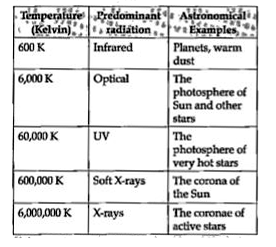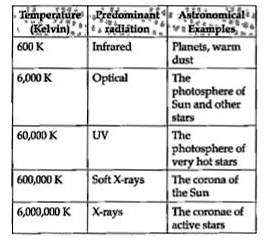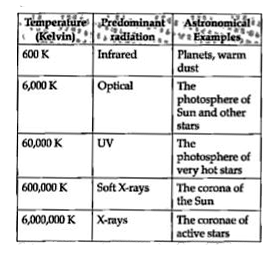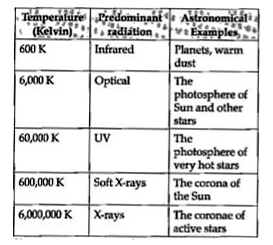PASSAGE - IV : A group of stars which forms a recognizable pattern or shape is called a constellation. So far 88 constellations have been recognized and named. Like stars, constellation also appear to move from east to west in the sky.
Which of the following constellation is also known as saptarishi ?
Casiopiea
Scorpius
Ursa Major
Ursa Minor
The correct Answer is:C
Topper's Solved these Questions
- BOOK - MTG IIT JEE FOUNDATIONCHAPTER - STARS AND THE SOLAR SYSTEM EXERCISE - Exercise (Subjective Problems (Very Short Answer Type))13videos
STARS AND THE SOLAR SYSTEM
- BOOK - MTG IIT JEE FOUNDATIONCHAPTER - STARS AND THE SOLAR SYSTEM EXERCISE - Exercise (Subjective Problems ( Short Answer Type))15videos
STARS AND THE SOLAR SYSTEM
- BOOK - MTG IIT JEE FOUNDATIONCHAPTER - STARS AND THE SOLAR SYSTEM EXERCISE - Exercise (Assertion & Reason Type)10videos
STARS AND THE SOLAR SYSTEM
- BOOK - MTG IIT JEE FOUNDATIONCHAPTER - SOUND EXERCISE - OLYMPIAD/HOTS CORNER15videos
SOUND
- BOOK - MTG IIT JEE FOUNDATIONCHAPTER - TEMPERATURE AND HEATEXERCISE - EXERCISE (INTEGER/NUMERICAL VALUE TYPE)5videos
TEMPERATURE AND HEAT
Similar Questions
Knowledge Check
- Question 1 - Select One
Consider the following statements A and B and choose the correct answer.
A. The celestial bodies which have their own light and heat are called planets.
B. A group of stars which follow a certain pattern are called constellation.AA is true, B is falseBBoth A and B are falseCA is false, B is trueDBoth A and B are true - Question 2 - Select One
Read the following text and answer the following questions on the basis of the same:
Spectrum Analysis and Astronomy
Each element in the periodic table can appear in gaseous form and produce its own spectrum unique to that element. Hydrogen will not look like Helium, which wil not look like carbon which will not look like iron....and soon. Astrophysists can identify what kinds of materials are present in stars from the analysis of star's spectra. This type of study is called astronomical spectroscopy. The science of spectroscopy is quite sophisticated. From spectrum lines analysis astrophysists can determine not only the element, but the temperature and density of that element in the star. The spectral line also can tell us about any magnetic field of the star. The width of the line can tell us how fast the material is moving. We can learn about winds in stars from this. The shifting of spectral liens shift back and forth indicates that the star may be orbiting another star. The following table shows a rough guide for the relationship between the temperature of a star and the electromagnetic spectrum.

If the spectrum of a star is red or blue shifted, then it can be used to infer its velocity along the line of sight. Edwin Hubble observed that more distant galaxies tended to have more red shifted spectra. This establishes the theory of expansion of the universe.
From the spectrum analysis the following information of a star can be obtainedAElements present, temperatureBMagnetic field, density, massCdistance of the starDBoth A and B - Question 3 - Select One
Read the following text and answer the following questions on the basis of the same:
Spectrum Analysis and Astronomy
Each element in the periodic table can appear in gaseous form and produce its own spectrum unique to that element. Hydrogen will not look like Helium, which will not look like carbon which will not look like iron....and soon. Astrophysists can identify what kinds of materials are present in stars from the analysis of star's spectra. This type of study is called astronomical spectroscopy. The science of spectroscopy is quite sophisticated. From spectrum lines analysis astrophysists can determine not only the element, but the temperature and density of that element in the star. The spectral line also can tell us about any magnetic field of the star. The width of the line can tell us how fast the material is moving. We can learn about winds in stars from this. The shifting of spectral liens shift back and forth indicates that the star may be orbiting another star. The following table shows a rough guide for the relationship between the temperature of a star and the electromagnetic spectrum.

If the spectrum of a star is red or blue shifted, then it can be used to infer its velocity along the line of sight. Edwin Hubble observed that more distant galaxies tended to have more red shifted spectra. This establishes the theory of expansion of the universe.
Which nature of spectrum establishes the theory of the expanding universe?ARed -shift of spectrumBBlue-shift of spectrumCBack and forth movemetn of spectral linesDNone of the above
Fill in the following blanks with suitable words :
The group of stars that appears to from a recognisable pattern in the sky is known as…………………..View SolutionX is a group of stars which is visible during the summer season in the early part of the night. It can be seen clearly in the month of April in the northern part of the sky. It resembles a bowl with a handle. It also resembles as big kite with a tail.
What is the general name of group of stars like X ?View SolutionRead the following text and answer the following questions on the basis of the same:
Spectrum Analysis and Astronomy
Each element in the periodic table can appear in gaseous form and produce its own spectrum unique to that element. Hydrogen will not look like Helium, which will not look like carbon which will not look like iron....and soon. Astrophysists can identify what kinds of materials are present in stars from the analysis of star's spectra. This type of study is called astronomical spectroscopy. The science of spectroscopy is quite sophisticated. From spectrum lines analysis astrophysists can determine not only the element, but the temperature and density of that element in the star. The spectral line also can tell us about any magnetic field of the star. The width of the line can tell us how fast the material is moving. We can learn about winds in stars from this. The shifting of spectral liens shift back and forth indicates that the star may be orbiting another star. The following table shows a rough guide for the relationship between the temperature of a star and the electromagnetic spectrum.

If the spectrum of a star is red or blue shifted, then it can be used to infer its velocity along the line of sight. Edwin Hubble observed that more distant galaxies tended to have more red shifted spectra. This establishes the theory of expansion of the universe.
What is astronomical spectroscopy?View SolutionRead the following text and answer the following questions on the basis of the same:
Spectrum Analysis and Astronomy
Each element in the periodic table can appear in gaseous form and produce its own spectrum unique to that element. Hydrogen will not look like Helium, which wil not look like carbon which will not look like iron....and soon. Astrophysists can identify what kinds of materials are present in stars from the analysis of star's spectra. This type of study is called astronomical spectroscopy. The science of spectroscopy is quite sophisticated. From spectrum lines analysis astrophysists can determine not only the element, but the temperature and density of that element in the star. The spectral line also can tell us about any magnetic field of the star. The width of the line can tell us how fast the material is moving. We can learn about winds in stars from this. The shifting of spectral liens shift back and forth indicates that the star may be orbiting another star. The following table shows a rough guide for the relationship between the temperature of a star and the electromagnetic spectrum.

If the spectrum of a star is red or blue shifted, then it can be used to infer its velocity along the line of sight. Edwin Hubble observed that more distant galaxies tended to have more red shifted spectra. This establishes the theory of expansion of the universe.
What may be the approximate temperature if soft X-rays are found predominantly in the spectrum?View SolutionRead the following text and answer the following questions on the basis of the same:
Spectrum Analysis and Astronomy
Each element in the periodic table can appear in gaseous form and produce its own spectrum unique to that element. Hydrogen will not look like Helium, which will not look like carbon which will not look like iron....and soon. Astrophysists can identify what kinds of materials are present in stars from the analysis of star's spectra. This type of study is called astronomical spectroscopy. The science of spectroscopy is quite sophisticated. From spectrum lines analysis astrophysists can determine not only the element, but the temperature and density of that element in the star. The spectral line also can tell us about any magnetic field of the star. The width of the line can tell us how fast the material is moving. We can learn about winds in stars from this. The shifting of spectral liens shift back and forth indicates that the star may be orbiting another star. The following table shows a rough guide for the relationship between the temperature of a star and the electromagnetic spectrum.

If the spectrum of a star is red or blue shifted, then it can be used to infer its velocity along the line of sight. Edwin Hubble observed that more distant galaxies tended to have more red shifted spectra. This establishes the theory of expansion of the universe.
The lines in a star's spectrum is found to shift back and forth. What conclusion may be drawn from this observation?View Solution
